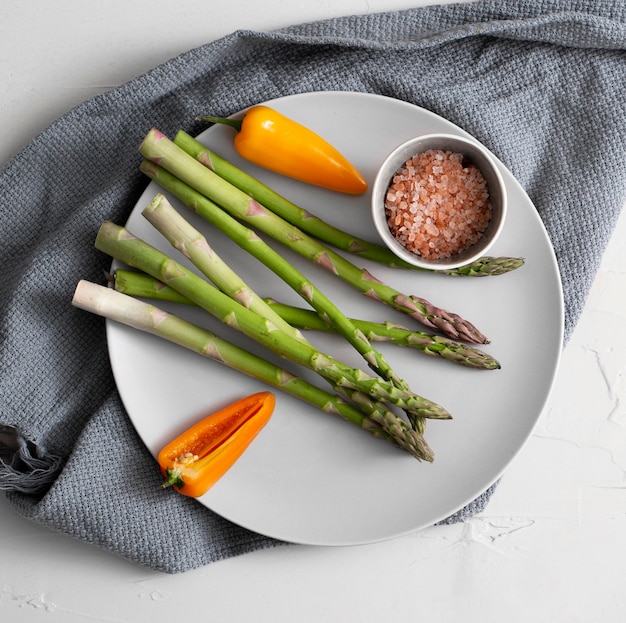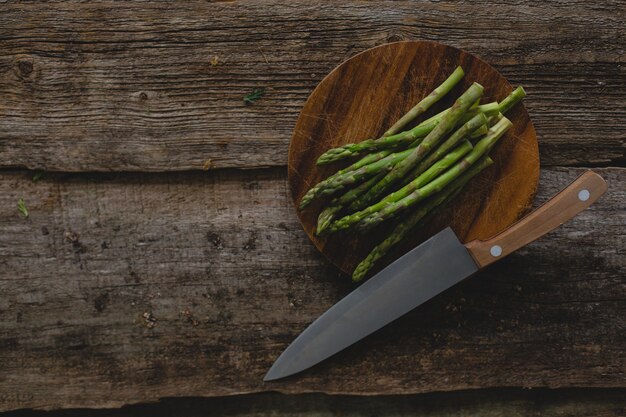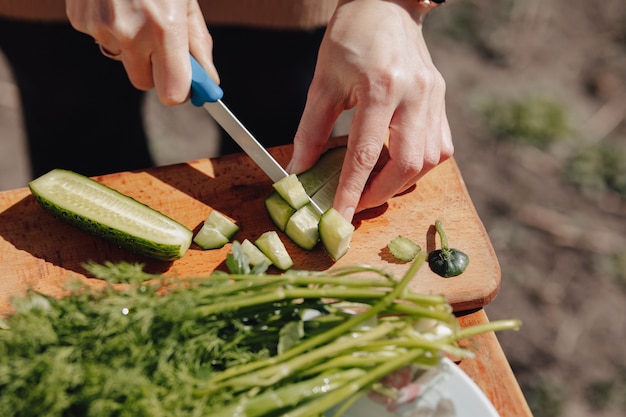There’s something truly magical about fresh asparagus. The vibrant green spears, bursting with spring’s promise, always make me feel like I’m holding a bit of sunshine in my hands. I’ve loved asparagus for as long as I can remember, but even I have to admit, sometimes you just don’t know what to do with it! That’s where this guide comes in. I’m going to walk you through everything you need to know about picking, preparing, and cooking asparagus, from the most basic techniques to some more creative recipes. So, grab your apron, let’s get cooking!
(Part 1) Picking the perfect asparagus

The first step to an amazing asparagus dish is choosing the right spears. It’s like a treasure hunt, and knowing what to look for can make all the difference.
The Asparagus Hunt: Finding Your Ideal Spears
You know how spring feels in the air? That's the feeling you’ll get walking into a farmers’ market or a greengrocer during asparagus season. The vibrant green bundles will be calling out to you, begging to be turned into culinary delights. And they’ll look so good, you’ll want to grab them all!
But hold your horses, my friend! Before you fill your basket, take a minute to look closely. You want spears that are firm and crisp, not limp and floppy. They should snap back when you bend them gently, like a spring. The tips should be closed and tight, with no signs of opening or wilting. The spears themselves should have a vibrant, even green colour. If you see any asparagus that’s discoloured, dry, or has blemishes, give it a pass. Fresh is always best!
Know Your Asparagus: Varieties and Their Traits
You might be surprised to learn there’s more to asparagus than just green. Here’s a quick rundown of the main varieties and their unique qualities:
- Green Asparagus: The most common variety, known for its bright green colour and slightly bitter flavour. It’s the most versatile and readily available, making it perfect for everything from simple roasting to elaborate dishes. It’s my personal favourite!
- White Asparagus: This variety is grown underground, giving it a creamy white colour. It has a milder, more delicate flavour than green asparagus and is often enjoyed with rich sauces like hollandaise. It’s a real treat!
- Purple Asparagus: This unique variety boasts a stunning purple colour and a slightly sweet flavour. It’s often enjoyed raw, lightly steamed, or grilled, allowing its delicate flavour to shine.
Don’t be afraid to experiment with different types of asparagus to discover your favourites. You might even find a hidden gem you never knew you loved!
(Part 2) preparing asparagus: A Step-by-Step Guide

You’ve got your perfect asparagus, now it’s time to prep them for their culinary debut. It’s a quick and easy process, and the result is beautifully prepared asparagus, ready to be transformed into delicious dishes.
Trimming the Tails: A Quick and Easy Task
The first step is to give those asparagus tails a trim. The ends are often tough and woody, and they won't be very pleasant to eat. There's a trick I learned from my grandmother that makes trimming a breeze: Simply snap off the end of the spear. It will break naturally where the woody part starts. If you're feeling fancy, you can also use a sharp knife to cut off the tough ends. Either way, you want to get rid of that woody bit before cooking.
Washing Away the Soil: A Refreshing Rinse
Next, it's time for a good wash! Run the asparagus under cool water to remove any lingering dirt or debris. I like to put them in a bowl of cold water for a few minutes to ensure they’re thoroughly clean. If you’re feeling extra meticulous, use a vegetable brush to scrub away any stubborn dirt. It’s all about making sure your asparagus is pristine and ready to shine.
Peeling for Perfection: Optional, but Worth Considering
This is a matter of personal preference. Some people like to peel their asparagus, especially if they’re using thicker spears. Peeling removes the tough outer layer, making the asparagus even more tender and easier to digest. I don’t always peel mine, but I find it can be a helpful step, especially for thicker spears. Use a vegetable peeler, but be gentle. You don't want to remove too much of the asparagus, just the tough bits. A light peel is all you need.
(Part 3) Roasting: The Ultimate Way to Enhance Asparagus' Flavour

Roasting is my go-to method for cooking asparagus. It brings out its natural sweetness and creates a beautifully caramelized flavour. It’s a simple yet elegant technique, perfect for any occasion, from a casual weeknight dinner to a fancy dinner party.
The Simple Roast: A Classic for a Reason
Preheat your oven to 180°C (350°F). Toss the asparagus with a drizzle of olive oil, a pinch of salt, and a few grinds of pepper. Spread the spears in a single layer on a baking sheet. Pop them into the oven and roast for 10-15 minutes, or until tender and slightly browned. The key is to make sure the asparagus isn't overcooked. You want that beautiful springy texture and vibrant green colour. If it gets mushy, you’ve gone too far!
Roasted with Garlic: A Savoury Delight
For a burst of savoury flavour, add a few cloves of minced garlic to the asparagus with the olive oil and seasoning. The garlic will roast alongside the asparagus, infusing it with its rich, savoury aroma. It's a simple addition that makes a big difference. Personally, I like to add a generous amount of garlic, but that’s just me! Feel free to adjust to your taste.
Lemon Roasted: A Bright and Tangy Twist
If you love a little zing in your asparagus, try a squeeze of lemon juice. The lemon juice will caramelize in the oven, adding a bright citrusy note to the asparagus. You can also add a sprinkle of lemon zest for an extra burst of flavour. This method is a real winner for those who enjoy a bit of tangy contrast.
(Part 4) Stir-Frying: A Speedy and Savoury Option
Looking for a quick and easy way to cook asparagus? Stir-frying is the way to go! It’s a great way to keep the asparagus vibrant and crisp, and it lends itself to a variety of flavours.
The Basic Stir-Fry: A Speedy and Delicious Method
Heat a wok or large skillet over high heat. Add a tablespoon of oil and heat until it shimmers. Add the asparagus and stir-fry for 2-3 minutes, or until tender-crisp. Season with salt and pepper. That’s it! Simple, quick, and incredibly delicious.
Stir-Fried with Soy Sauce: A Savoury and Umami-Rich Dish
For a boost of umami flavour, add a splash of soy sauce to the pan during the last minute of cooking. The soy sauce will caramelize slightly, creating a delicious glaze for the asparagus. It’s a fantastic way to add depth and richness to your stir-fry.
Stir-Fried with Ginger: A Zesty and Aromatic Delight
Ginger is a fantastic addition to stir-fried asparagus, adding a bright and aromatic element. Simply add a tablespoon of grated ginger to the pan with the asparagus and stir-fry until fragrant. The ginger will infuse the asparagus with its warming, spicy flavour, creating a truly satisfying dish. Personally, I love the combination of ginger and asparagus. It’s a match made in culinary heaven!
(Part 5) Steaming: A Gentle and Healthy Approach
If you’re looking for a healthy and gentle way to cook asparagus, steaming is your best bet. It preserves the asparagus’s nutrients and keeps its vibrant green colour, allowing you to truly enjoy its natural flavour. It’s a great option for those who want to enjoy asparagus in its purest form.
The Simple Steam: Light and Refreshing
Fill a steamer basket with water and bring it to a boil. Add the asparagus to the basket and steam for 3-5 minutes, or until tender-crisp. Season with salt and pepper. The steam will cook the asparagus gently, preserving its delicate flavour and texture.
Steamed with Herbs: A Fragrant and Aromatic Dish
To add a touch of aromatic magic to your steamed asparagus, add a handful of fresh herbs to the steamer basket. Herbs like dill, parsley, or tarragon will infuse the asparagus with their delicious flavours as they steam. It’s a great way to add a touch of elegance to your simple steamed asparagus.
Steamed with Lemon: A Bright and Zesty Option
For a bright and refreshing twist, add a squeeze of lemon juice to the steam basket with the asparagus. The lemon juice will infuse the asparagus with its tangy flavour, creating a light and refreshing dish. It’s a perfect pairing for any meal.
(Part 6) Grilling: A Summery and Smoky Delight
grilling asparagus is a perfect way to enjoy it during the warmer months. The smoky flavour from the grill adds a wonderful depth to the asparagus, creating a delicious and satisfying dish. It’s also a great option for outdoor entertaining, adding a touch of summery charm to your table.
The Simple Grill: Smoky and Delicious
Preheat your grill to medium heat. Toss the asparagus with a little olive oil, salt, and pepper. Place the spears on the grill and cook for 3-5 minutes per side, or until tender-crisp and slightly charred. The simple act of grilling creates a delicious smoky flavour that will tantalize your taste buds. Don't overcook the asparagus, you want to maintain that lovely springy texture!
Grilled with Herbs: A Flavorful and Aromatic Dish
For a more flavourful and aromatic grilling experience, add a handful of fresh herbs like rosemary or thyme to the grill along with the asparagus. The herbs will infuse the asparagus with their delicious flavours as they cook. It’s a great way to create a unique and unforgettable grilling experience.
Grilled with Balsamic: A Sweet and Tangy Twist
If you want to add a touch of sweetness and tang to your grilled asparagus, drizzle a little balsamic vinegar over the spears before grilling. The balsamic vinegar will caramelize on the grill, creating a delicious glaze for the asparagus. It's a fantastic way to add complexity and depth to your grilled asparagus.
(Part 7) Asparagus in Recipes: Beyond the Basic
Asparagus is much more than just a side dish. It’s a versatile ingredient with the potential to be a star in your kitchen! Let’s explore some delicious recipes that showcase asparagus in all its glory.
Asparagus and Prosciutto Tart: A Savoury and Elegant Delight
This tart is a real crowd-pleaser, perfect for a dinner party or a casual gathering. It's easy to make and absolutely delicious. Simply lay out a sheet of puff pastry, top it with roasted asparagus, sliced prosciutto, and a sprinkling of Parmesan cheese. Bake until the pastry is golden brown and the cheese is melted. The combination of asparagus, prosciutto, and Parmesan creates a symphony of savoury flavours.
Asparagus and Mushroom Risotto: A Creamy and Comforting Dish
This creamy and comforting risotto is perfect for a chilly evening. Start with a classic risotto base, then add chopped asparagus and sautéed mushrooms. The asparagus and mushrooms will add a delightful earthy flavour to the risotto, creating a dish that’s both comforting and sophisticated. It’s a true culinary hug in a bowl!
Asparagus and Goat Cheese Salad: A Light and Refreshing Option
This light and refreshing salad is perfect for a summer lunch or dinner. Toss together some fresh asparagus, crumbled goat cheese, and a vinaigrette dressing. The asparagus adds a touch of sweetness and bitterness, while the goat cheese adds creaminess and tang, creating a perfect balance of flavours. It’s a simple, yet satisfying salad that’s sure to please.
(Part 8) Asparagus Preservation: Making it Last Longer
We all know asparagus season is fleeting. But don’t despair! You can still enjoy this delicious vegetable long after it’s gone from the markets. Here’s how to preserve asparagus and enjoy its deliciousness all year round.
Freezing Asparagus: A Simple and Convenient Option
Freezing asparagus is a simple and convenient way to preserve it. Simply blanch the asparagus for 2-3 minutes in boiling water, then plunge it into ice water to stop the cooking process. Drain and dry the asparagus thoroughly, then place it in freezer bags. Frozen asparagus can be stored for up to 6 months. It’s a great way to enjoy asparagus year-round, without any compromise in flavour or texture.
Pickling Asparagus: A Tangy and Delicious Treat
Pickling asparagus is a delicious way to preserve it and add a tangy twist to your culinary repertoire. Simply combine asparagus spears with a brine solution of vinegar, salt, sugar, and spices. Let the asparagus pickle for several weeks, and you’ll have a tangy and delicious treat that can be enjoyed on its own or as a condiment. It’s a wonderful way to add a touch of sophistication to your meals.
Drying Asparagus: A Versatile and Flavorful Option
Drying asparagus is a great way to create a versatile and flavorful ingredient that can be used in a variety of dishes. Simply slice the asparagus and dry it in a food dehydrator or oven until brittle. Dried asparagus can be used in soups, stews, or even ground into a powder for a unique flavour boost. It’s a fantastic option for those who enjoy adding a little something extra to their cooking.
(Part 9) Asparagus FAQs: Answering Your Burning Questions
You’ve learned a lot about asparagus, but there are always questions, right? I’ve got you covered. Here are some frequently asked questions and their answers:
1. How Long Does Asparagus Last in the Fridge?
Fresh asparagus can last up to 5 days in the refrigerator if stored properly. Wrap the spears in a damp paper towel and place them in a plastic bag. Store the bag in the crisper drawer of your refrigerator. Avoid storing asparagus near strong-smelling fruits or vegetables, as it can absorb their flavours. And hey, if you're not sure if it's still good, give it a sniff. If it smells off, it's probably time to toss it.
2. Can You Eat the White Part of Asparagus?
The white part of the asparagus is the stalk, and it's actually perfectly edible. However, it's often tougher than the green part. You can trim the white part and cook it with the green part. Or, you can peel the white part to remove the tough outer layer. Just make sure to cook it a bit longer than the green part to ensure it's tender.
3. What Does Asparagus Smell Like?
This is a bit of a funny one! Some people say that asparagus pee smells like asparagus! It's a common occurrence after eating asparagus, and it's due to a compound called asparagusic acid. Don't worry, it's perfectly harmless and it's actually a sign that you're digesting the asparagus properly. It’s a bit of a strange thing, but hey, it’s part of the asparagus experience!
4. Is Asparagus Good for You?
Absolutely! Asparagus is packed with nutrients and vitamins. It's a good source of fibre, vitamin K, folate, and vitamin C. It's also low in calories and fat. So, enjoy it with a clear conscience! It’s a delicious and healthy addition to any diet.
5. What Can You Serve with Asparagus?
Asparagus is a versatile vegetable that can be paired with a wide variety of dishes. It’s great as a side dish for grilled meats, fish, or poultry. It also makes a delicious addition to salads, pasta dishes, and omelets. Get creative and experiment with different flavour combinations. You’ll be surprised at how many ways you can enjoy this wonderful vegetable.
So there you have it, a comprehensive guide to cooking fresh asparagus. I hope you've enjoyed this journey through the world of asparagus and are now ready to embark on your own culinary adventures. Happy cooking!
Everyone is watching

How to Cook Frozen Lobster Tails Perfectly: A Step-by-Step Guide
RecipesLobster. Just the word conjures up images of lavish meals, special occasions, and a taste of luxury. But let's...

Pork Fillet Cooking Time: How Long to Cook It Perfectly
RecipesPork fillet, or tenderloin as it's sometimes called, is a real favourite in our house. It's so versatile, and...

Pigs in a Blanket Cooking Time: How Long to Bake for Perfect Results
RecipesAh, pigs in a blanket. Just the name conjures up images of those delightful little parcels of crispy pastry en...

The Ultimate Guide to Cooking Delicious Frankfurters
RecipesLet's face it, we all love a good frankfurter. It's a classic, simple, and always satisfying. But let's be rea...

Wolf Meat Recipes: A Guide to Cooking Wild Game
RecipesLet's be honest, you don't see wolf meat at your local butcher shop every day. It's a bit of a wild card, but ...
